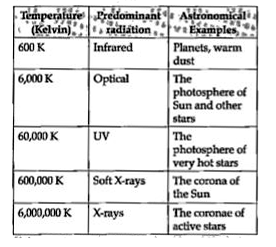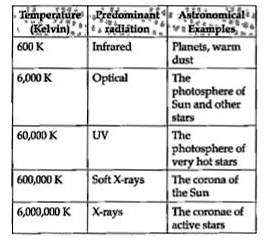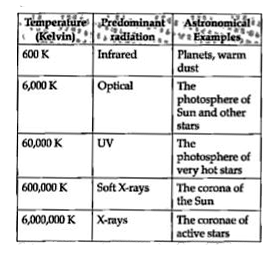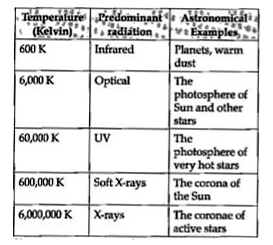Read the following text and answer the following questions on the basis of the same:
Spectrum Analysis and Astronomy
Each element in the periodic table can appear in gaseous form and produce its own spectrum unique to that element. Hydrogen will not look like Helium, which will not look like carbon which will not look like iron....and soon. Astrophysists can identify what kinds of materials are present in stars from the analysis of star's spectra. This type of study is called astronomical spectroscopy. The science of spectroscopy is quite sophisticated. From spectrum lines analysis astrophysists can determine not only the element, but the temperature and density of that element in the star. The spectral line also can tell us about any magnetic field of the star. The width of the line can tell us how fast the material is moving. We can learn about winds in stars from this. The shifting of spectral liens shift back and forth indicates that the star may be orbiting another star. The following table shows a rough guide for the relationship between the temperature of a star and the electromagnetic spectrum.

If the spectrum of a star is red or blue shifted, then it can be used to infer its velocity along the line of sight. Edwin Hubble observed that more distant galaxies tended to have more red shifted spectra. This establishes the theory of expansion of the universe.
What is astronomical spectroscopy?
Study of spectrum of star light and to identify its distance from Earth.
Study spectrum of star light and to identify what kinds of elements are present in stars
Both A and B
None of the above
The correct Answer is:B
Astrophysists can identify what kinds of material are present in stars from the analysis of star.s spectra. This type of study is called astronomical spectroscopy.
Similar Questions
Knowledge Check
Read the following text and answer the following questions on the basis of the same:
Spectrum Analysis and Astronomy
Each element in the periodic table can appear in gaseous form and produce its own spectrum unique to that element. Hydrogen will not look like Helium, which wil not look like carbon which will not look like iron....and soon. Astrophysists can identify what kinds of materials are present in stars from the analysis of star's spectra. This type of study is called astronomical spectroscopy. The science of spectroscopy is quite sophisticated. From spectrum lines analysis astrophysists can determine not only the element, but the temperature and density of that element in the star. The spectral line also can tell us about any magnetic field of the star. The width of the line can tell us how fast the material is moving. We can learn about winds in stars from this. The shifting of spectral liens shift back and forth indicates that the star may be orbiting another star. The following table shows a rough guide for the relationship between the temperature of a star and the electromagnetic spectrum.

If the spectrum of a star is red or blue shifted, then it can be used to infer its velocity along the line of sight. Edwin Hubble observed that more distant galaxies tended to have more red shifted spectra. This establishes the theory of expansion of the universe.
From the spectrum analysis the following information of a star can be obtainedAElements present, temperatureBMagnetic field, density, massCdistance of the starDBoth A and BRead the following text and answer the following questions on the basis of the same:
Spectrum Analysis and Astronomy
Each element in the periodic table can appear in gaseous form and produce its own spectrum unique to that element. Hydrogen will not look like Helium, which will not look like carbon which will not look like iron....and soon. Astrophysists can identify what kinds of materials are present in stars from the analysis of star's spectra. This type of study is called astronomical spectroscopy. The science of spectroscopy is quite sophisticated. From spectrum lines analysis astrophysists can determine not only the element, but the temperature and density of that element in the star. The spectral line also can tell us about any magnetic field of the star. The width of the line can tell us how fast the material is moving. We can learn about winds in stars from this. The shifting of spectral liens shift back and forth indicates that the star may be orbiting another star. The following table shows a rough guide for the relationship between the temperature of a star and the electromagnetic spectrum.

If the spectrum of a star is red or blue shifted, then it can be used to infer its velocity along the line of sight. Edwin Hubble observed that more distant galaxies tended to have more red shifted spectra. This establishes the theory of expansion of the universe.
Which nature of spectrum establishes the theory of the expanding universe?ARed -shift of spectrumBBlue-shift of spectrumCBack and forth movemetn of spectral linesDNone of the aboveRead the following text and answer the following questions on the basis of the same:
Spectrum Analysis and Astronomy
Each element in the periodic table can appear in gaseous form and produce its own spectrum unique to that element. Hydrogen will not look like Helium, which wil not look like carbon which will not look like iron....and soon. Astrophysists can identify what kinds of materials are present in stars from the analysis of star's spectra. This type of study is called astronomical spectroscopy. The science of spectroscopy is quite sophisticated. From spectrum lines analysis astrophysists can determine not only the element, but the temperature and density of that element in the star. The spectral line also can tell us about any magnetic field of the star. The width of the line can tell us how fast the material is moving. We can learn about winds in stars from this. The shifting of spectral liens shift back and forth indicates that the star may be orbiting another star. The following table shows a rough guide for the relationship between the temperature of a star and the electromagnetic spectrum.

If the spectrum of a star is red or blue shifted, then it can be used to infer its velocity along the line of sight. Edwin Hubble observed that more distant galaxies tended to have more red shifted spectra. This establishes the theory of expansion of the universe.
What may be the approximate temperature if soft X-rays are found predominantly in the spectrum?A60000CB600000CC60000KD600000K
What does a neuron look like?
View SolutionWhat does a neuron look like?
View SolutionWhat did he look like ?
View SolutionLook at the figure and answer the following questions:

What kind of mirror is used here?
View SolutionRead the following text and answer the following questions on the basis of the same:
Spectrum Analysis and Astronomy
Each element in the periodic table can appear in gaseous form and produce its own spectrum unique to that element. Hydrogen will not look like Helium, which will not look like carbon which will not look like iron....and soon. Astrophysists can identify what kinds of materials are present in stars from the analysis of star's spectra. This type of study is called astronomical spectroscopy. The science of spectroscopy is quite sophisticated. From spectrum lines analysis astrophysists can determine not only the element, but the temperature and density of that element in the star. The spectral line also can tell us about any magnetic field of the star. The width of the line can tell us how fast the material is moving. We can learn about winds in stars from this. The shifting of spectral liens shift back and forth indicates that the star may be orbiting another star. The following table shows a rough guide for the relationship between the temperature of a star and the electromagnetic spectrum.

If the spectrum of a star is red or blue shifted, then it can be used to infer its velocity along the line of sight. Edwin Hubble observed that more distant galaxies tended to have more red shifted spectra. This establishes the theory of expansion of the universe.
The lines in a star's spectrum is found to shift back and forth. What conclusion may be drawn from this observation?
View Solution
